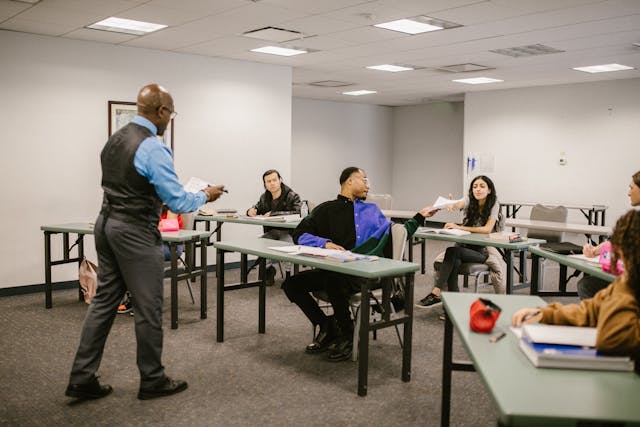DEI Examples in schools

Diversity, equity, and inclusion (DEI) efforts help students feel respected and offer a sense of belonging. It means every student has a fair chance to succeed, regardless of their academic background, social circumstances, or financial situation. DEI in schools centers on academic engagement, achievement, and representation that promote social-emotional development.
DEI fosters empathy, belonging, and confidence by providing students with a pathway to success. Despite the many benefits of prioritizing DEI in schools, though, implementing DEI initiatives can be a complex undertaking. Differing views within communities and political resistance in some areas can pose challenges. However, educators have a significant opportunity to establish equity in education when they prioritize DEI.
Continue reading as we share practical DEI examples that schools can use.
1. Inclusive curriculum design
Inclusive classroom curricula should reflect the diverse voices and experiences of a variety of learners. It ensures exposure and accessibility, often requiring updates to textbooks and lesson plans.
Materials that incorporate the history and contributions of diverse perspectives and cultures can enhance retention and graduation rates. One study found a 10–15% increase in retention rates in minority students after a culturally responsive curriculum was implemented. Being able to see themselves and others in learning materials helps to deepen students’ understanding, motivation, and empathy.
This doesn’t mean just adding random diversity to content, though. It takes enriching entire curriculum plans so students can learn to appreciate different viewpoints. An inclusive curriculum supports a sense of belonging and enhances critical thinking skills that are necessary for future success.
2. Diverse perspectives in education
Incorporating multiple viewpoints into lessons and subjects broadens understanding and promotes empathy. For example, you might invite guest speakers from different backgrounds or implement cultural and social contexts into lesson plans. When faculty represent different cultures and knowledge, students benefit. Studies have shown a correlation between faculty diversity and higher graduation rates at universities. Your DEI initiatives can enhance student engagement and create opportunities for inclusive dialogue.
When diversity is in literature, history, and STEM units, students can explore topics more deeply. They’re encouraged to step outside their comfort zones and develop a mindset that prepares them for life beyond school.
3. Varied teaching methods
Another way to make instruction more DEI-focused is by varying teaching methods. You can foster multiple learning styles and acknowledge cultural backgrounds using techniques like:
- Differentiated instruction: Uses tailored assignments and flexible small groups.
- Universal Design for Learning (UDL): Offers multiple ways for students to learn.
- Project-based learning: Provides opportunities for real-world problem solving.
- Multimodal approaches that cater to diverse learners: Offer visual, auditory, and kinesthetic options for learning.
- Flexibility that supports engagement: Offers choices in tasks, pacing, assessment opportunities, and deadlines.
- Culturally responsive teaching training: Trains educators to implement lessons that reflect and celebrate students’ backgrounds.
- Collaborative learning: Utilizes group projects and fosters constructive feedback.
- Accessible resources and materials: Makes resources like captioned videos and screen readers available.
- Positive classroom and school cultures: Prioritizes respect, a sense of belonging, and supportive norms in the classroom and throughout schools.
These techniques give students meaningful, real-world access to learning. Beyond that, they make achievement possible for all learners, including those with diverse learning needs and from different cultural backgrounds.
4. Student affinity groups
When you support affinity groups across campus, you can establish safe spaces for students. These are the places where students can connect with peers who share similar identities and interests. Racial and ethnic groups, LGBTQIA+ communities, neurodiverse learners, and other interest-based groups will all benefit from having support that validates their identities and promotes peer interaction.
Groups should be healthy, safe learning environments that include mentorship dialogue and offer a sense of belonging. They can be student-led or staff-supported, but they’re a crucial part of any school’s DEI efforts.
Student affinity groups and DEI examples in schools:
- Interdisciplinary student groups
- Disability groups
- Students of color groups
- LGBTQIA+ groups
- Gender expression groups
- Young professional groups
- Racial and ethnic identity groups
5. Cultural events
Cultural celebrations help students experience and share their backgrounds. Heritage months, multicultural fairs, assemblies, and international days are all excellent opportunities for student-led performances and to share presentations, art, and food. These events foster understanding and pride. They’re more than just festive, fun days, though. They provide opportunities to educate students and build an inclusive school culture that values diversity.
“When schools are able to celebrate cultural events, it helps to show students that all are welcome, safe, and celebrated. This helps students feel like they belong when they see all cultures, including theirs, being represented.”
- Laura Magnuson, MA, MS, LAMFT, VP of Clinical Engagement
6. Cultural competency training for staff
Cultural competency refers to the ability to engage in effective, respectful interactions with others from diverse backgrounds. If you want to create lasting change as a leader, this is a big piece of the equation. Training ensures staff and faculty have the tools they need to build inclusive classrooms and recognize existing biases.
Workshops, bias-awareness training, and ongoing professional development equip teachers with the tools to support their students. Benefits include improving classroom dynamics and overall student mental health. Teachers with cultural competency can build stronger relationships and evaluate students more fairly.
“When educators and staff are able to approach and speak with students in a culturally competent manner it shows the student that they are understood and assists with a sense of belonging. This can help to improve student wellbeing.”
- Laura Magnuson, MA, MS, LAMFT, VP of Clinical Engagement
7. Targeted support
Targeted programs that use mentors, tutors, and counselors can help close the achievement gap among underserved populations. A data-driven approach allows you to allocate resources and interventions more effectively. It enables leaders to distribute funds based on the most pressing student needs.
8. Support for multilingual families
DEI initiatives don’t end at the classroom door. Showing respect for parents with language differences can strengthen partnerships. It will benefit student outcomes by promoting engagement and trust between school and home. You can provide translation services, bilingual staff, and other culturally sensitive communication methods to connect with families and caregivers who have limited proficiency in English.
9. Equity dashboards
Being able to visualize data through equity dashboards promotes transparency and enables data-driven decision-making. Key metrics, such as grades, attendance, discipline, and participation, can be analyzed by race, gender, or other demographic categories. By tracking and acknowledging disparities, you can focus on the strategic efforts that will have the most impact.
10. Equitable resource allocation
All students should have equitable access to experienced teachers, school resources, materials, technology, and extracurricular programs. Districts can improve distribution by identifying and redirecting resources to address the needs of underserved student populations. This levels the playing field and supports academic growth, success, and well-being.
11. Accessible technology and learning tools
Adaptive technologies are more accessible today than ever before. Assistive devices and tools, like text-to-speech, screen readers, accessible learning platforms, and captioning, all help ensure that students with disabilities or different learning styles can fully participate in lessons. When you prioritize the availability of accessible tools and technology, you’re reaffirming your commitment to inclusion and equal opportunities for all students.
Mental health support for student well-being
DEI education initiatives support student emotional and mental wellness. Creating inclusive policies helps students explore their own (and others’) identities while feeling safe in their school environment. Leveraging services like Talkspace’s online therapy for students is one way schools can offer mental health support that enhances student well-being and resilience.
DEI in schools isn’t just about policies or events. It’s a framework that fundamentally enhances social-emotional health by creating an equitable environment where all students have the support they need. Request a demo today to learn more about how Talkspace can be a supportive resource for students navigating any challenges, including those related to diversity, equity, and inclusion.
Sources:
- Fagun, Olufemi. 2025. “The Future of Diversity, Equity and Inclusion in Higher Education in United States.” International Journal of Research and Innovation in Social Science IX (IIIS): 1164–75.DEI fosters empathy, belonging, and confidence by providing students with a pathway to success. Despite the many benefits of prioritizing DEI in schools, though, implementing DEI initiatives can be a complex undertaking. Differing views within communities and political resistance in some areas can pose challenges. However, educators have a significant opportunity to establish equity in education when they prioritize DEI.. Accessed November 5, 2025.
- Stout, Rebecca, Cephas Archie, David Cross, and Carol A. Carman. 2018. “The Relationship Between Faculty Diversity and Graduation Rates in Higher Education.” Intercultural Education 29 (3): 399–417. https://doi.org/10.1080/14675986.2018.1437997. Accessed November 5, 2025.






